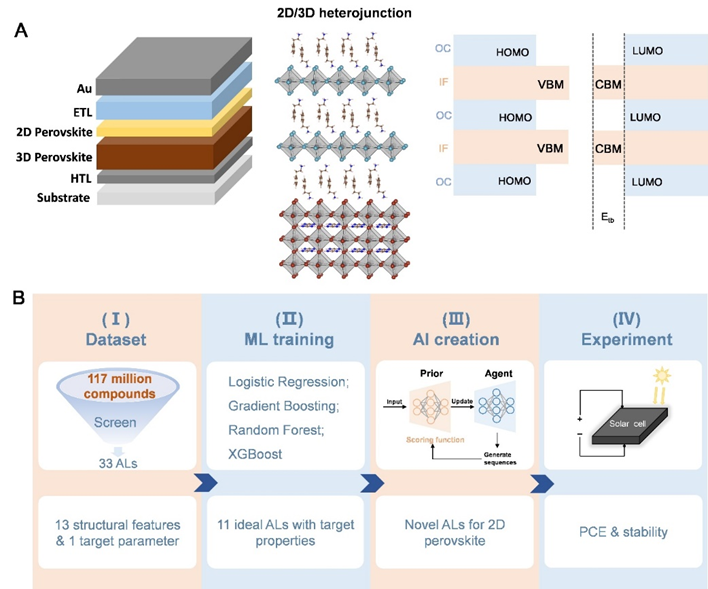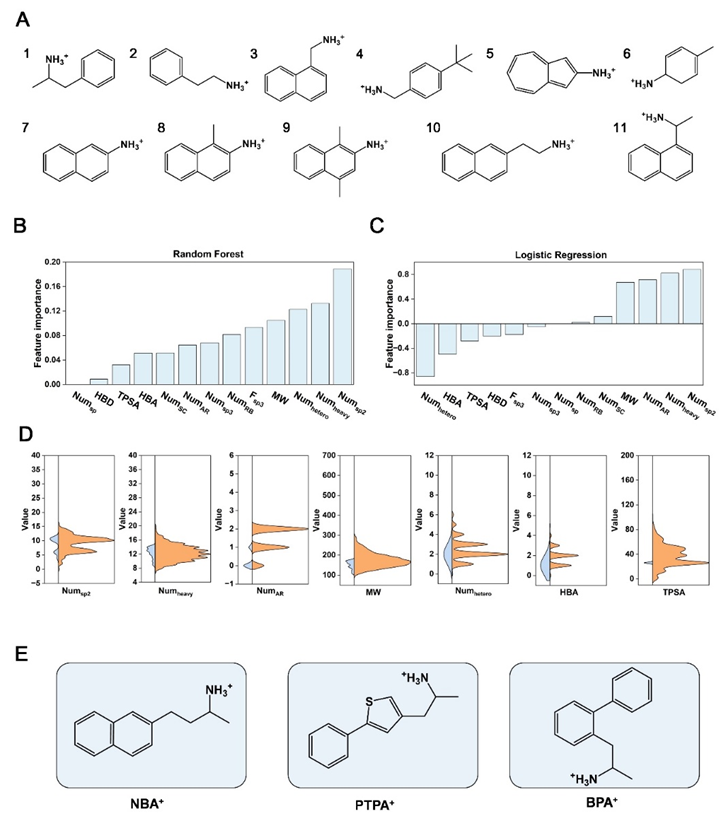Recently, researchers from the School of Materials Science and Technology at Shanghai Jiao Tong University harnessed artificial intelligence (AI) to accelerate the development of innovative materials for perovskite solar cells. The research article, titled "AI-Generated Ammonium Ligands for High-Efficiency and Stable 2D/3D Heterojunction Perovskite Solar Cells", was published in Advanced Materials. (https://advanced.onlinelibrary.wiley.com/doi/10.1002/adma.202503154). The research was led by Associate Professor Qifeng Han, with PhD students Ge Yan and Hongcai Tang serving as co-first authors.
2D/3D heterojunction perovskite solar cells exhibit significantly excellent stability compared to traditional 3D perovskite solar cells. However, the periodic quantum well structure, consisting of alternating stacks of ammonium ligands (ALs) and inorganic [PbI6] layers in the 2D perovskite, creates a transport barrier (Etb) that restricts carrier movement and consequently lowers power conversion efficiency. Despite efforts to reduce the periodic Etb between ALs and [PbI6] layers, the complex nature of ALs led to a one-sided understanding of how Etb relates to ALs, resulting in less effective material designs. Moreover, the current approach to exploring ALs relies on inefficient trial-and-error methods, which slows down the development of 2D/3D perovskite solar cells.
To address this issue, the research team developed a Dataset-ML training-AI creation-Experiment (DMAE) workflow. DMAE used machine learning to explore the relationship between feature parameters (the structure of ammonium ligands) and target parameters (carrier transport barrier) and trained the established dataset using four different machine learning models. This determined the impact weight of each feature parameter on carrier transport. Based on this, DMAE employed an AI model based on reinforcement learning algorithms to design ALs with the desired properties. By using 11 ALs with lower Etb values as inputs and applying transfer learning method, a novel ammonium ligand, 1-(5-phenylthiophen-3-yl)propan-2-amine hydroiodide (PTPAI) was successfully designed. The Etb value is only 0.03 eV, greatly improving the carrier transport performance of the corresponding 2D perovskite.
Finally, the team used PTPAI to prepare 2D/3D heterojunction inverted perovskite solar cells, achieving a certified power conversion efficiency of 26.12%. The devices retained 96.79% of the initial PCE after 2000 hours operation in maximum power point tracking under 1-sun illumination at 85°C. These results are significantly better than the control group, demonstrating the feasibility of AI-assisted design of ammonium ligands in 2D/3D heterojunction perovskite solar cells. This work offers novel insights and forward-looking perspectives for the application of artificial intelligence in the material development of perovskite solar cells.
The research work was supported by the National Key R&D Program of China (grants 2020YFB1506400 and 2021YFB3800100) and the National Natural Science Foundation of China (grants U20A20245, U21A20171, 11834011, and 12074245).

Figure 1: (A), Schematic diagram of 2D/3D heterostructure p-i-n perovskite solar cells and the quantum well structure in 2D perovskite. OC is organic cations, IF is inorganic framework. (B), Schematic diagram of the workflow of DMAE.

Figure 2: (A), Structure diagram of 11 ALs with low Etb. (B), Feature importance obtained from the Random Forest model. (C), Feature importance obtained from the Logistic Regression model. (D), Feature parameters distributions of 11 input molecules (blue area) and 3692 AI output molecules (orange area). (E), Structural diagrams of three optimal AI-designed ALs.
Figure 3: (A), XRD patterns of 2D perovskite films based on PEAI, NAI, NBAI, PTPAI, BPAI. (B), PL spectra of 2D/3D heterojunction perovskite films. (C), C-AFM mappings of 2D perovskite films. (D), SCLC curves of the electron-only devices based on 2D perovskites. (E), TRPL mappings of the 3D perovskite/2D perovskite/ETL/Au films.
